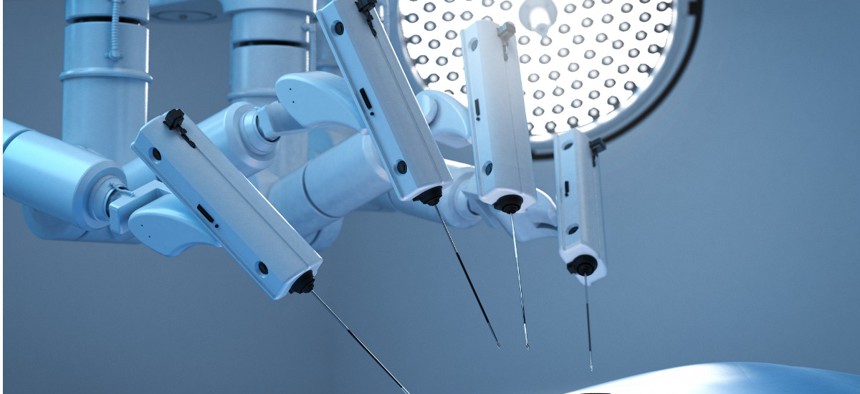Pentagon Preps to Experiment with Robotic Surgery, Augmented Reality Via 5G

PhonlamaiPhoto/istockphoto
A request for product proposals is in the pipeline.
The Pentagon is getting ready to roll out an experiment at Joint Base San Antonio that will involve the making of full-scale prototypes for telemedicine applications expected to run in real-time on a 5G core network.
In a recently issued statement of work, the Defense Department shed some light on this in-the-works project, which will encompass the implementation of technologies like augmented reality, machine learning and telerobotic surgery supported by that next-generation connectivity.
“The sensor densification in 5G, the low latency in 5G—all of those characteristics of the technology are going to enhance future capabilities in medicine—and that's the purpose of this SOW and the technical areas that surround it,” National Spectrum Consortium Vice Chairman Randy Clark told Nextgov in a recent interview. “And it's really for the good of the nation.”
Rapid speeds and massive capacity connections offered by 5G hold the potential to drastically transform how healthcare is delivered. The DOD last June named JBSA as the experimentation site specifically for 5G in telemedicine and medical training. This pilot is part of the second tranche of military installations the Pentagon is steering as part of an ambitious effort to explore and prototype 5G-enabled technologies in support of its mission.
The 41-page statement of work, shared with Nextgov, requests input from industry, but comes ahead of a more formal request for project proposals the department will release. In this initial document, Defense officials said the enterprise aims to first focus on the necessary steps for 5G technology integration with telemedicine and medical training.
Four technical areas of focus are listed: 5G enabled AR guided medical training, 5G advanced telehealth information access, 5G telementoring via AR and 5G advanced telerobotic surgery for medical procedures. Under that last operation-centered technical area, the objective is to develop a 5G-enabled remote telerobotic surgery prototype. The telehealth information access-aligned project will explore how the technology can provide mobile enhancements capable of on-demand access to patient electronic health records—including imaging studies and links to other networks that may contain relevant patient health data. And the AR-focused technical realms will involve work to prototype that emerging technology for various applicable uses.
“The purpose of this experiment area is to provide a secure, resilient and fully integrated 5G platform to extend operational medical expertise forward to the ‘Operational Edge,’ provide real-time medical telementoring capable of virtually reaching anyone, anywhere in the world, provide virtual real-time medical training anywhere in the world, and fuse with other advanced technologies (i.e., Augmented Reality (AR), Machine Learning (ML), Artificial Intelligence (AI), robotic machine),” officials wrote in the document. “It is expected that the steps to deploy 5G Telemedicine on a global basis truly will be informed by this effort.”
Currently, the National Spectrum Consortium has 420 members—and due to an other transaction authority with DOD, only those companies, nonprofits and academic organizations will be able to apply to participate in this work. Membership is open, but those who join must first be formally vetted by the Homeland Security Department.
“We don't want our competitors or national near-peer competitors involved in our experimentation,” NSC’s Clark told Nextgov.
On top of serving as the consortium’s vice-chair, Clark is a client partner for defense and national security agencies at Verizon. He also served as a Marine Corps communicator in the first Gulf War. Back then, in the late 1980s and early 1990s, the tactical deployed computer system being used in those operations was enormous, “like it filled up a 10 by 10 room,” he recalled. But now, various features of 5G will enable military insiders to compute much more, much faster, with potentially less of a physical footprint.
Those 5G elements could allow officials to densify thermal, infrared, sound video and other sensors into an area of operation and essentially gain a three dimensional map of that space and common operational picture in near real-time. The latency that will be offered, Clark noted, could allow for a round trip communication between the computer doing the analytics and the sensor providing the data in under a dozen milliseconds.
“It takes 250 milliseconds for you to blink your eye—and the network is going to be making decisions through automation in 10 milliseconds or less. How many decisions are going to be made by an automated environment in the amount of time a dismounted warrior blinks their eye?” Clark said. “That's the kind of impact we're talking about.”






